Methodology: Statements of Working (Form 27) of Indian Mobile Device Patents
In India, if a patent is not locally worked within three years of its issuance, any person may request a compulsory license, and if the patent is not adequately worked within two years of the grant of such a compulsory license, it may be revoked. In order to provide the public with information about patent working, India requires every patentee to file an annual statement on “Form 27” describing the working of each of its issued Indian patents. We conducted the first comprehensive and systematic study of all Forms 27 filed with respect to mobile devices. We tried to empirically establish the extent to which patentees and licensees comply with the statutory requirement to declare information about the working of their patents. Research assistance was provided by interns Anna Liz Thomas and Nayana Dasgupta.
The research paper on patent landscape, Patents and Mobile Devices in India: An Empirical Survey, [PDF] was published in the Vanderbilt Journal of Transnational Law (2017).
The research paper on "Patent Working Requirements and Complex Products: An Empirical Assessment of India's Form 27 Practice and Compliance" has been published here (July 2017).
The dataset of all the Form 27 studied for this paper has been published here.
Research Questions
- How many annual Form 27 submissions have been made to the Indian Patent Office for 4,419 granted patents identified in the landscape of mobile device patents in India?
- How many patents have no corresponding Form 27 filed yet?
- How many Form 27 submissions from those found are defective?
- Is there an identifiable pattern in the defects and discrepancies?
- Is there any discernible trend in filing of Form 27 over time and with respect to patent owners?
The objective of this paper is to quantitatively determine the extent to which patentees and licensees comply with the statutory requirement to declare information about the working of their patents according to Section 146(2) of the Patents Act, 1970 read with Rule 131 of the Patent Rules, 2003.
Section 146(2): Without prejudice to the provisions of sub-section (1), every patentee and every licensee (whether exclusive or otherwise) shall furnish in such manner and form and at such intervals (not being less than six months) as may be prescribed statements as to the extent to which the patented invention has been worked on a commercial scale in India.
Rule 131: Form and manner in which statements required under section 146(2) to be furnished
- The statements shall be furnished by every patentee and every licensee under sub-section (2) of section 146 in Form 27 which shall be duly verified by the patentee or the licensee or his authorised agent.
- The statements referred to in sub-rule (1) shall be furnished in respect of every calendar year within three months of the end of each year.
- The Controller may publish the information received by him under sub-section (1) or sub-section (2) of section 146.
Object
The research object is Form 27 submissions made annually to the Indian Patent Office for the 4,419 granted patents.
4,052 of these patents were identified in the landscape (“the patent landscape”) developed by the Centre for Internet and Society as a part of ongoing research on patents pertaining to sub-USD-100 mobile devices sold in India. The dataset of the patent landscape can be accessed here. Another 367 patents pertaining to mobile technology identified during the landscaping exercise but excluded from it, were added to the initial set of 4,052 patents.
A blank copy of Form 27 is available here. The pro forma is defined as per Schedule II of Patent Rules, 2003.
Research Methods
[Corresponding research questions
- How many annual Form 27 submissions have been made to the Indian Patent Office for 4,419 granted patents identified in the landscape of mobile device patents in India?
- How many patents have no corresponding Form 27 filed yet?
- How many Form 27 submissions from those found are defective?]
Outsourcing the searching of the submitted copies of Form 27 to a contractor
Owing to the repetitive nature of the process for collecting the forms, as well the large scale of the project, the task of searching was outsourced to a contractor. Price quotations were invited from five data entry operators and two firms of patent attorneys. On the basis of the quotation, deliverable time, scope and nature of the results delivered, and quality assurance, the contract was awarded to one firm. The firm offered the best price for a commensurate deliverable time and assured quality of results.
Form 27 retrieval online
Form 27 were searched from IPAIRS (Indian Patent Information Retrieval System) and InPASS (Indian Patent Advanced Search System) public databases of the Indian Patent Office.
InPASS has two features: Application Status and E-Register. We checked both features, in case forms not found through one could be located through the other. We indeed found that, sometimes, the forms not available on E-register could be found through the Application Status table, and vice versa.
Case 1: Accessing form 27 using Application Status tab on INPASS
- A search portal is located at ipindiaservices.gov.in/publicsearch.
- Enter the patent number in the “Patent Number” search field without the kind codes (IN) and click on “Search”. E.g., for patent number IN263932B, enter ‘263932’ in the “Patent Number” field.
- Once the queried patent is displayed, select the “Application Status” tab to access the list of documents that were filed for the requested patent.
- In the Application Status tab, scroll down to the bottom to view “Application Status table”. Click on the “View Documents” button to access the list of the documents filed for the queried patent. A pop-up window opens with the results.
- In the window, a list of hyperlinks to various documents is displayed. Sometimes Form 27/ working statement is explicitly named so. At other times, it may have a different title. Once you click on the form 27 link, a PDF file opens in a new tab. There may be more than one Form 27 in the list of documents as Form 27 is an annual submission.
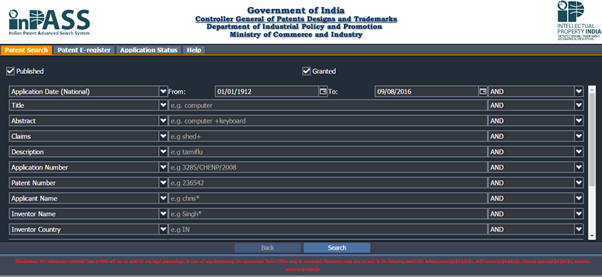
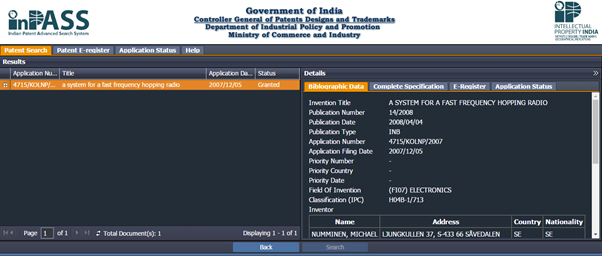
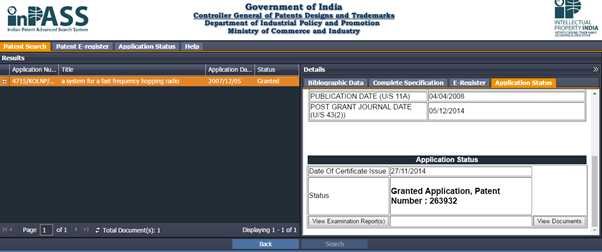
Case 2: No record of Form 27 found (Application status tab)
If the form is not present on InPASS, that is, if it has not been uploaded to the website, or if it has not been submitted to the Indian Patent Office (IPO), then it will not be displayed in the list of documents described in Case 1, step 5. Such instances have been logged as “No record found”.
Case 3: Accessing form 27 using E-Register tab on INPASS
- At http://ipindiaservices.gov.in/publicsearch, a patent search portal is displayed. Enter the patent number by following the same steps as described in Case 1 until the queried patent is displayed. Select the “E-register” tab to access the e-register data corresponding to the queried patent.
- In the “E-register” tab, scroll to the bottom to view the “Information u/s 146” table. The “Information u/s 146” table includes a list of Form 27 filed for the queried patent. As visible in the screenshot below, on clicking the “261762_2015” hyperlink, Form 27 for the queried patent opens. There could be multiple form 27s corresponding to different years.

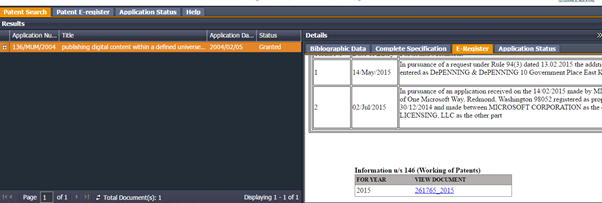
Case 4: No record of Form 27 found (E-register)
If the form is not present in the E-register, that is, if it has not been uploaded to the website or if it has not been submitted to the IPO, then the E-Register tab displays “Eregister Not Available”.
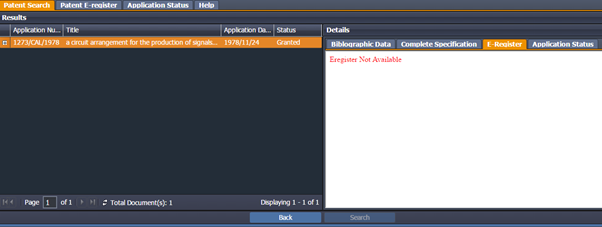
Case 5: Searching on IPAIRS
Both InPASS and IPAIRS fetch forms from the same URL. However, we observed that one search engine sometimes displays the forms when the other doesn’t. The IPAIRS search engine was used when Form 27 was not found on InPASS.
- IPAIRS patent search homepage: http://ipindiaonline.gov.in/patentsearch/search/index.aspx On the home page, in the Application Status tab, enter the full patent application number and CAPTCHA.
- A window containing information pertaining to the patent application opens. At the bottom of the window, there is a “View Documents” button.
- On clicking on “View Documents”, a new window with list of hyperlinked documents opens as described in Case 1, Step 5.
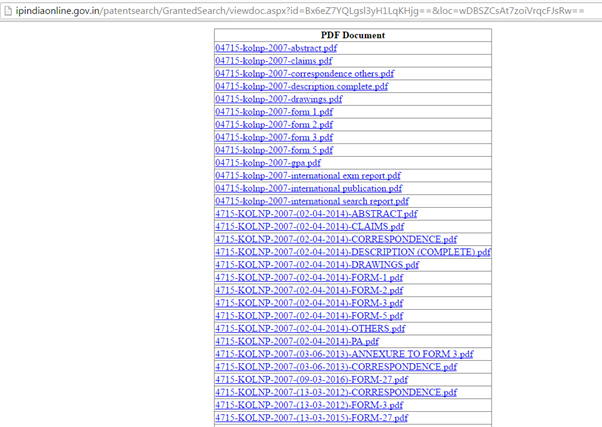
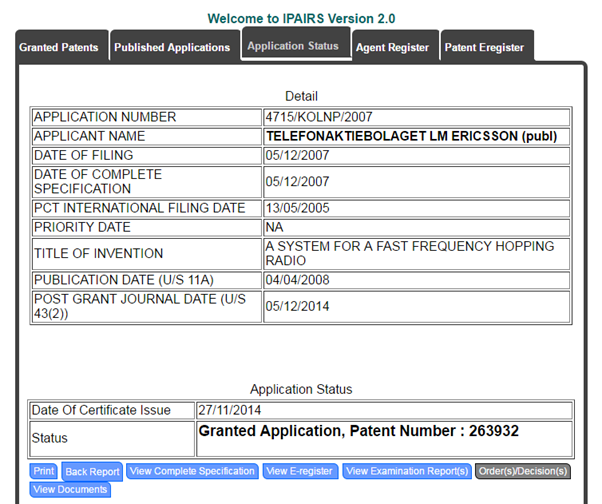
The URL for the new window displayed via “View Documents” on IPAIRS is the same as the URL displayed via “View Documents” in the “Application Status” tab on InPASS. For example, for patent number 263932, the URL for this window is the same on IPAIRS and InPASS: http://ipindiaonline.gov.in/patentsearch/GrantedSearch/viewdoc.aspx?id=Bx6eZ7YQLgsl3yH1LqKHjg==&loc=wDBSZCsAt7zoiVrqcFJsRw==
Form 27 retrieval via Right To Information (RTI) requests
CIS filed two requests under the RTI Act, 2005 with the Office of the Controller General of Patents, Designs, and Trade Marks in Mumbai.
- CIS' RTI application to the Indian Patent Office in Mumbai, March 2016 [PDF]. The IPO's reply, April 2016 [PDF].
(View text: https://cis-india.org/a2k/blogs/rti-request-to-indian-patents-office-for-form-27-statement-of-working-of-patents-2015)
InPASS and IPAIRS yielded Form 27 for 1,999 patents out of 4,419. For Form 27 pertaining to 61 of the remaining patents, CIS made a request in March 2016 under the Right to Information Act (2005) to the office of the Indian Patent Office located in Mumbai.
How the 61 patents were chosen
37 of the 50 companies in the patent landscape owned granted patents. We took one patent from each of the 37 companies. [See Annexure 4 (PDF)of Methodology: Patent landscaping in the Indian mobile device market] The remaining were patents litigated in India, as well as patents transferred from one of the companies in the landscape to another.
IPO’s reply to the March 2016 RTI application
The IPO replied in April 2016 that it could provide CIS with forms for eleven of the requested patents. As for the rest of the forms, the IPO stated, “As thousand [sic] of Form-27 are filed in this office, it is very difficult to segregate Form-27 for the patent numbers enlisted in your RTI application as it needs diversion of huge official/ staff manpower and it will affect day to day [sic] work of this office.”
Repeating the Form 27 search online
A few days after CIS received the reply from the IPO, Form 27 pertaining to patents in the landscape started appearing on InPASS and IPAIRS E-register portal. CIS’ contractor repeated the search for forms for all 4,419 patents as some forms filed in 2016 and 2015 were found. Forms for additional 1,003 patents were found, taking the number of patents with at least one corresponding form to 3,002.
Of the 1,417 patents for which forms were not found, 481 are either expired or there is no log corresponding to them in the E-Register.
Schema for the results
Information from the Form 27 was logged into a spreadsheet with the following heads:
Serial Number -- Assignee -- Patent Number -- Status -- Application Date -- Grant Date -- Title -- Application Number -- Form 27 presence -- Multiple Forms -- Number of years -- Year -- If Worked -- Working/ Non-working Status -- Working/ Non-working Information -- Licensing Status -- Licensing Information -- Comments.
Detailed legend and process of logging the results
Assignee: Name of the company that owns the patent. Annexure 4 [PDF] lists 50 companies studied for the patent landscape. 37 of those companies owned patents in India. Thus, the assignee could be one of 37 companies among the 50 in Annexure 4. Where two assignees are mentioned, the patent was transferred from the second assignee to the first on account of sale of the patent, company merger, etc. For example, "Huawei|NEC" indicates that a patent that belonged to NEC was transferred to Huawei.
Form 27 presence: Whether or not Form 27 was found. Entries in this column are either “Yes” or “No”. If case Form 27 was not found, the subsequent columns are unpopulated.
Multiple Forms: If more than one Form 27 was found, the number of years for which it was found. In some cases, more than one form was found for the same patent for the same year. We have considered these instances as a single form for the same year and noted the defect in the “Comments” column.
Year: The year for which the form was filed. This information was found in #2 of the pro forma of Form 27. In the case of patents with Form 27 filed for more than one year, the entries for different years have been logged into consecutive rows.
If Worked: This information was found in 3(i) of the pro forma. Depending on whether the text of Form 27 states that the patent was “worked” or “not worked”, results have been logged as either “Yes” or “No”. In instances where it is not explicitly stated whether the patent has been worked or not, or where 3(i) is blank, the results are logged as “Not disclosed” with a description of the defect in the “Comments” column.
Working/ Non-working status: Corresponds to 3(i)a in the case of patents stated as “worked” and to 3(i)b in the case of those stated as “not worked”. The results have been marked as:
- Description is generic (future use)
- Description is generic (present use)
- Description is specific
- No description
Description is generic (future use): No specific information been provided as required by 3(i)a or 3(i)b. The description indicates that in the future the patentee might “work” or license the patent or do both. E.g: “May be worked in the future depending on the market demand and when technology is mature.”
Or
“We are still assessing the commercial and technological aspects of working of this patent in India and negotiating marketing and distribution of patented product with related parties.”
Or
“Technical developments [sic] are still continuing” or “Negotiations and technical developments [sic] are still continuing”.
Description is generic (present use): No specific information been provided as required by 3(i)a or 3(i)b. The description indicates that the patentee may be “working” the patent. E.g:, “DUE TO THE NATURE OF THE INVENTION, IT IS NOT POSSIBLE TO DETERMINE ACCURATELY WHETHER THE PATENTED INVENTION HAS BEEN WORKED IN INDIA OR NOT. Improvements in the invention are continuing to be made. The Patentee is actively looking for licensees and customers to commercialise the invention in the Indian environment.”
Or
“... This patent is among a large number of patents in the patentee’s complex portfolio which may cover the products services and embedded technologies provided by the patentee or its licensee(s) in India. This patent might worked [sic] in India in some of the patentee(s) existing or future products, services and embedded technologies. Given the extremely Iarge number of patents that may apply to any given product or service of the patentee, it is very difficult to Identify and accurately update which of those patents would apply to the numerous products, services and embedded technologies.”
Description is specific: Specific information has been provided as required in 3(i)a or 3(i)b.
E.g, “Quantum of the patented product-303520 and value of the patented product in INR-2790524299”.
No description: 3(i)a and 3(i)b are blank.
Working/non-working information: Contains the full text of the descriptions mentioned in “Working/non-working status” column. These have been reproduced verbatim from Form 27 filings.
Licensing status: States whether or not the patent has been licensed as per 3(ii) of the pro forma for Form 27. Results are logged as “Yes” (licensed), “No” (no-licensed), “Cross-licensed” and “Not disclosed”.
“Not disclosed” indicates that the response to 3(ii) is either blank or there is an explicit statement that licensing information would not be disclosed on Form 27. E.g: “As all the licenses are confidential in nature, the details pertaining to the same are not being disclosed herein and may be provided to the Patent Office as and when the same is specifically directed by the Patent Office under sealed cover so that such details are not laid open in public domain.”
Licensing information: Contains the full text of the response reproduced verbatim from 3(ii). (Blank fields when there is no text in 3(ii))
For patents marked as licensed, this column contains the names and addresses of licensees and/ or sub-licensees.
For patents marked as not-licensed, this column is either blank or contains statements such as, “Information Not readily available; efforts will be made to collect and submit further information, if asked for.”, “None”, “No licensees”.
For patents marked as “cross-licensed”, the patentee states that it has a cross-licensing agreement with its licensees. E.g: “There is a cross license agreement between <company name> and at least one licensee, giving mutual rights to produce despite monopoly afforded by patents that are hold by any of the companies. There is no information available on whether the technology of said patent is included products sold by such licensee. As all the licenses are confidential in nature, the details pertaining to the same shall be provided under specific directions from the Patent Office.”
Comments: Contains information about defects and notable observations from the Form 27 submissions.
Validation of results
Validation of the results was done via deduplication first and then random sampling of 10% of the results.
Analysis of results
[Corresponding research questions:
4. Is there an identifiable pattern in the defects and discrepancies?
5. Is there any discernible trend in filing of Form 27 over time and with respect to patent owners?]
The results logged into the spreadsheet were analysed to find a pattern in the defects in the submissions. Visualisations will be created, if necessary.
Prior Art
- Extraordinary writ petition in the matter of a public interest litigation, filed in the High Court of Delhi, Shamnad Basheer vs Union of India and others, C.M. No. 5590 of 2015 http://spicyip.com/wp-content/uploads/2015/05/FORM-27-WP-1R-copy.pdf
The petitioner(s) “sought to investigate the commercial working of certain patented inventions in India, particularly in relation to three key areas”. One of these areas include telecommunications technology. Para 53 to 58 of the writ elucidate on the petitioners’ observations and findings on “High technology patents and trolls”, while para 59 and 60 refer to the linkage between patents and products. Annexure P-8 of this petition contains copies of Form 27 filed by Ericsson in India. Annexure P-11 contains a “summary of findings of Form 27 investigations conducted by the petitioner”. Annexure P-4 (II. Telecommunications Sector) contains a list of 58 patents pertaining to the telecommunications domain in India. 21 of these are coincide with the patent landscape mentioned in “Research Object”. - Basheer had published a report in 2011 based on the findings of his RTI investigation of Form 27 pertaining to pharmaceutical patents in India. The report titled “RTI Applications and “Working” of Foreign Drugs in India?” is available at: http://www.spicyip.com/docs/Workingpatents.doc The report sheds light on lack of filing, incomplete filing and violation of patent working norms by pharmaceutical companies. He states having encountered difficulties during the RTI process: The RTI process was a very arduous one, with the patent office refusing information or claiming missing files in some cases. We had to resort to the appellate procedure in almost all cases. And in one case concerning the drugs Tarceva and Sutent, both the CPIO (Delhi office) and the appellate authority refused to provide information. We had to then take the matter up directly with Controller General PH Kurian who immediately ordered that the information be provided. Upon his instructions, the information was provided within 24 hours. However, we received this information only on the 4th of April 2011, more than 6 months since we began the RTI process! (Source: Drug Firms and Patent "Working": Extent of Compliance with Form 27 http://spicyip.com/2011/04/drug-firms-and-patent-working-extent-of.html
Limitations
- If Form 27 is not found on InPASS or INPAIRS, it is not possible to determine if the form has not been submitted to the IPO or it has been submitted but the IPO has not uploaded it. There is no publicly available database or log where such information is available.
- Technical issues with the IPAIRS website hampered the speed of searching for and downloading Form 27. At the time of trial run in May 2015, the website was not available for nearly a week. Technical issues also lead to conflicting search results on IPAIRS and INPASS at times. For example, the form may be available via one search engine but not via another, even though they are fetched the files from the same database. Runtime errors occur due to browser caching.
Edited, September 10, 2017: To add -- URLs of the research paper on Form 27 published in July 2017, and of the dataset containing raw data, which was published and licensed CC-BY-SA 4.0.

